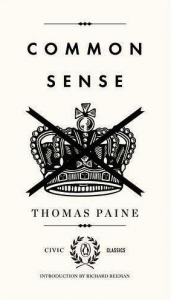 In the history of the written word, few documents have proven more incendiary than Thomas Paine’s “Common Sense.” Published anonymously in January of 1776, at the very beginning of the American Revolution, Paine’s pamphlet was a call to arms that helped galvanize the American peoples and ignite a war against an empire. Paine scholar and editor of my Modern Library edition, Howard Fast, writes in the introduction that Paine “was not interested in originating a philosophy; he intended only to turn what democratic philosophy existed into a program of action for men with guns.” And this is true. “Common Sense” is not a philosophical treatise: “he invited men to fight for freedom,” Fast writes, “whereas others invited men to think of it.” Thus Paine makes a case for American emancipation that is partly based on democratic ideals and a distrust of monarchy and partly based upon the practical matters of natural resources, government interest, foreign policy and economics. But it is the bold claim that both arguments belong under his larger rubric of ‘common sense’ that merits further attention, particularly as Paine’s views on government and liberty continue to define political debates to this day.
In the history of the written word, few documents have proven more incendiary than Thomas Paine’s “Common Sense.” Published anonymously in January of 1776, at the very beginning of the American Revolution, Paine’s pamphlet was a call to arms that helped galvanize the American peoples and ignite a war against an empire. Paine scholar and editor of my Modern Library edition, Howard Fast, writes in the introduction that Paine “was not interested in originating a philosophy; he intended only to turn what democratic philosophy existed into a program of action for men with guns.” And this is true. “Common Sense” is not a philosophical treatise: “he invited men to fight for freedom,” Fast writes, “whereas others invited men to think of it.” Thus Paine makes a case for American emancipation that is partly based on democratic ideals and a distrust of monarchy and partly based upon the practical matters of natural resources, government interest, foreign policy and economics. But it is the bold claim that both arguments belong under his larger rubric of ‘common sense’ that merits further attention, particularly as Paine’s views on government and liberty continue to define political debates to this day.
Three centuries have obscured the significance of the political battles of Paine’s lifetime, and we have, to our discredit, come to take for granted many of the hard-won liberties of his era. Chief among these is representative government, the right of a people to self-governance. Up to this point in time, the nations of the world were ruled by monarchs, who gained their power through military force and maintained a hereditary dynasty that often put children and the mentally ill in positions of incredible power. The union of church and state gave monarchs divine authority to rule, and centuries of indoctrination in this hierarchy made dissent taboo; anyone brave or foolish enough to publicly question the legitimacy of this system could expect brutal retribution. It took growing populations, urbanization, a wealthy merchant class and the invention of the printing press, allowing ideas to disseminate more quickly and without censorship, for the cracks in monarchical government to be exposed, but our debt is most obvious to the individuals who bore the brunt of the risk: William Hazlitt, William Godwin, Paine and the incomparable Mary Wollstonecraft.
Paine is acutely aware of this history (he calls monarchy “the popery of government”), and thus begins by distinguishing ‘society’ from ‘government’:
Society is produced by our wants, and government by our wickedness; the former promotes our happiness positively, by uniting our affections, the latter negatively by restraining our vices. […] Here then is the origin and rise of government; namely, a mode rendered necessary by the inability of moral virtue to govern the world.
Astute readers will recognize in this statement Paine’s stance on the question of human nature, a debate very much at the fore of 18th century intellectual discussion and which, amazingly, rages on to this day. Society, Paine argues, was produced out of mutual self-interest, the banding together of like-minded peoples to achieve a common goal, and governments followed as a necessary evil to restrain the natural greed and self-interest of men. But these governments were not representative, not of the people or for the people, but exploitative of the people, and thus had to be fought to establish individual liberty.
Paine’s pamphlet was wildly successful, going through over twenty different editions and selling in excess of 500,000 copies, making it, by a large margin, the most widely read political document in America. And, though he would later attach his name to it, he donated all of the profits to the Continental Army, effectively ‘putting his money where his mouth was.’ It remains incredibly readable, a product of its sermon-like qualities, and demands to be read, not only for its own sake, but for its clear influence on the drafting of the Declaration of Independence.